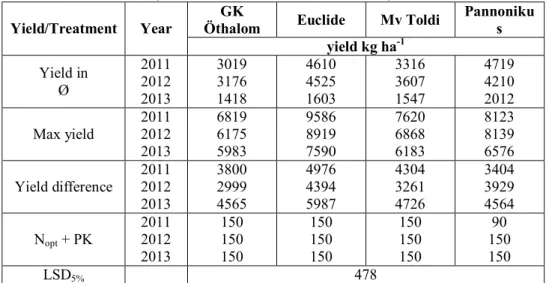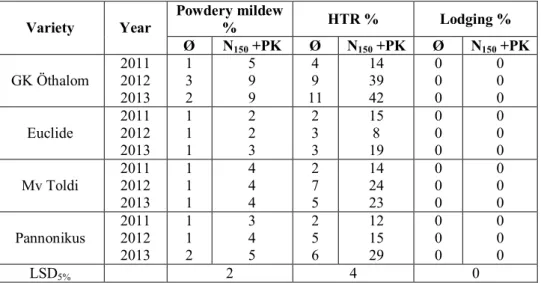Analele Universităţii din Oradea, Fascicula Protecţia Mediului Vol. XXI, 2013
FERTILIZATION RESPONSES OF GENOTYPES IN WINTER WHEAT (TRITICUM AESTIVUM L.) CROP MODELS
Pepó Péter*, Szilágyi Gergely*
* University of Debrecen CAAES, Faculty of Agricultural and Food Sciences and Environmental Management, Institute of Crop Sciences
Abstract
Fertilization responses of winter wheat (Triticum aestivum L.) genotypes (GK Öthalom, Euclide, Mv Toldi, Pannonikus) were studied in a long-term experiment on chernozem soil in 2011- 2013 cropyears. Our scientific results proved that there were variety-specific differences among the winter wheat varieties in natural nutrient utilization, maximum yields and yield-surpluses. The infections of leaf diseases of wheat were influenced by cropyears and genotypes. In the application of wheat crop models the variety-specific fertilization is the most important agrotechnical elements.
Key words: winter wheat, genotype, fertilization, crop models.
INTRODUCTION
Winter wheat has a decisive role in Hungarian crop production. The sowing area of wheat varies between 1.0-1.2 million ha. The national average yield of wheat was 5.0-5.5 t ha-1 in the 1980s but nowadays the average yield varies between 3.0-5.0 t ha-1 depending on the climatic factors of the cropyear (Pepó, 2004).
The climatic conditions have changed dramatically for the last century (Várallyay, 2007) which had a great influence on the possibilities of crop production in the temperate zone and on yield stability (Birkás et al., 2006).
Nutrient supply has a major role in wheat production (Pepó, 2004; Balogh et al., 2007), nitrogen is an especially important macroelement in the soil-plant system (Németh, 2006). The fertilizer response of wheat genotypes is variety-specific (Pepó, 2007).
MATERIAL AND METHOD
The long-term experiment was set up in 1983 on chernozem soil at the experimental station of the Crop Sciences Institute of the University of Debrecen Centre for Agricultural Sciences and Engineering, Faculty of Agriculture at Látókép. In addition to the control, the fertilizer response of the different wheat genotypes were studied in two-, three- four-and fivefold dosages of the basic treatment of N = 30 kg ha-1, P2O5 = 22.5 kg ha-1, K2O = 26.5 kg ha-1. The experiment was set up in a split-plot arrangement in four replicates. In each year, 15-20 wheat varieties were tested. Half of the nitrogen fertilizer dosage was applied in the autumn, the other half in early
spring, full dosages of phosphorus and potassium were applied in the autumn. The applied agrotechnique satisfied the requirements of modern production technology. The forecrop was sweet corn. The applied crop protection was the same in both years (weed control: Secator 0.3 kg ha-1, disease management: Falcon 460 EC 0.6 l ha-1 [at 2-3 nodi stage], Falcon 460 EC 0.8 l ha-1 [at the beginning of flowering]).
In this paper the results of 2011-2013 cropyears were evaluated. Table 1 and 2 show the most important agrometeorological parameters in the cropyears of 2011, 2012 and 2013, respectively.
Table 1 Rainfall (mm) in the cropyears of winter wheat
(Debrecen, 2011-2013)
Cropyear Oct Nov Dec Jan Feb March Apr May June Total 2010/11 22,8 52,9 104,2 19,2 16,8 35,1 15,6 52,3 22,0 340,9 2011/12 18,1 0 71,1 28,0 17,8 1,4 20,7 71,9 91,7 320,7 2012/13 22,4 16,6 65,8 38,7 52,9 136,3 48,0 68,7 30,8 480,2 Average
1961-90 of 30,8 45,2 43,5 37,0 30,2 33,5 42,4 58,8 79,5 400,9
Table 2 Temperature (oC) in the cropyears of winter wheat
(Debrecen, 2011-2013)
Cropyear Oct Nov Dec Jan Feb March Apr May June Mean 2010/11 6,9 7,7 -1,7 -1,2 -2,5 5,0 12,2 16,4 20,5 7,03 2011/12 8,6 0,6 1,5 -0,6 -5,7 6,3 11,7 16,4 20,9 6,63 2012/13 11,1 7,2 -1,2 -1,0 2,3 2,9 12,0 16,6 19,6 7,72 Average
1961-90 of 10,3 4,5 -0,2 -2,6 0,2 5,0 10,7 15,8 18,7 6,93
RESULTS AND DISCUSSION
Winter wheat is a crop with high nutrient requirements, both the higher or lower than optimal fertilizer dosages reduce the yield. The fertilizer response of winter wheat varieties with different genotypes have been studied in a long-term experiment on chernozem soil. The studied varieties were: GK Öthalom, Euclide, Mv Toldi and Pannonikus. Weather conditions in the three years showed great differences. Weather conditions in the vegetation period of 2011, were favoruable, almost optimal for the development and yield formation of winter wheat. The temperature during the vegetation period was also favourable for the vegetative and generative development of winter wheat. The specific features of the years manifested both in the yields and fertilizer responses of the wheat varieties (Table 3).
Table 3 Effects of cropyears, fertilization and genotypes on the yields of winter wheat
(Debrecen, 2011-2013, chernozem soil)
Öthalom GK Euclide Mv Toldi Pannoniku s Yield/Treatment Year
yield kg ha-1 Yield in
Ø
2011 2012 2013
3019 3176 1418
4610 4525 1603
3316 3607 1547
4719 4210 2012 Max yield 2011
2012 2013
6819 6175 5983
9586 8919 7590
7620 6868 6183
8123 8139 6576 Yield difference 2011
2012 2013
3800 2999 4565
4976 4394 5987
4304 3261 4726
3404 3929 4564 Nopt + PK 2011
2012 2013
150 150 150
150 150 150
150 150 150
150 90
LSD5% 478 150
In the favourable cropyear (2011) the maximum yields of wheat genotypes varied between 6800-9600 kg ha-1. In less favourable cropyears (2012 and 2013) the maximum yields decreased by 500-2000 kg ha-1 depending on the amount of rainfall, its distribution and temperature. So the maximum yield of winter wheat varieties varied between 6200-8900 kg ha-1 in 2012 year and 6000-7600 kg ha-1 in 2013 year, respectively. The difference in the maximum yield of varieties among the three years indicates the adaptation ability of the genotypes to different ecological stress factors.
During the period of 2011-2013 years Euclide varieties gave the highest maximum yields which proves its favourable abiotic stress tolerance.
For the evaluation of the wheat varieties from different genotypes, their natural nutrient utilization ability (yield of the control treatment), maximum yield, optimum N+PK fertilizer dosage and the extra yield from fertilization can be used.
The wheat varieties could utilize differently the natural stock of chernozem soil in different cropyears. We found similar natural utilization of genotypes (control treatment) in 2011 and 2012 years. The yields of control varied between 3000-4700 kg ha-1 in 2011 and 3100-4500 kg ha-1 in 2012, respectively. In 2013 cropyear we got low yields in the control because of cumulative effect of water deficit (1400-2000 kg ha-1). There were variety-specific differences among the natural nutrient utilization of genotypes. The varieties of Euclide and Pannonikus can be characterized by better natural nutrient utilization comparing with the varieties of GK Öthalom and Mv Toldi. The optimum N+PK doses were very similar in the
cropyears of 2011-2013 (except in 2011 year Pannonikus gave the maximum yield in the N90 +PK fertilizer treatment).
The infection level and the degree of lodging were determined by fertilization and genotype for all varieties (the same crop protection technology was applied in the years) (Table 4). The results proved that increased fertilizer dosages increased the degree of leaf diseases in three years (therefore, only the values of the control and the highest dosage, N150
+PK were included in Table 4). In addition to the fertilizer treatments, the level of leaf diseases was modified also by the year and the genotype.
Table 4 Effects of cropyears fertilization and genotypes the diseases and lodging of winter wheat
(Debrecen, 2011-2013) Powdery mildew
% HTR % Lodging %
Variety Year
Ø N150 +PK Ø N150 +PK Ø N150 +PK GK Öthalom 2011
2012 2013
1 3 2
5 9 9
4 9 11
14 39 42
0 0 0
0 0 0 Euclide 2011
2012 2013
1 1 1
2 2 3
2 3 3
15 8 19
0 0 0
0 0 0 Mv Toldi 2011
2012 2013
1 1 1
4 4 4
2 7 5
14 24 23
0 0 0
0 0 0 Pannonikus 2011
2012 2013
1 1 2
3 4 5
2 5 6
12 15 29
0 0 0
0 0
LSD5% 2 4 0 0
The infections of HTR were much higher than the infection of powdery mildew in all studied cropyears. In the N150 +PK treatment the infection of powdery mildew varied between 3-9%, the infection of HTR varied between 8-42% depending on the cropyears and genotypes. Among the studied varieties, Euclide showed a favourable tolerance to diseases in each cropyears. Because the special cropyears characterized by agrometeorological parameters the varieties proved good resistance to lodging.
CONCLUSIONS
Results of our long-term experiment proved that appropriate nutrient supply had a determining importance in increasing the yield of winter wheat also in chernozem soils with excellent water and nutrient management. The fertilizer response of winter wheat genotypes is variety-specific. Differences
were observed among the varieties in natural nutrient utilization, maximum yield, extra yield of fertilization and the optimum N+PK dosage. The utilization of the natural nutrients of the soil and the active ingredients of the fertilizers was determined basically by the weather. The level of leaf diseases and lodging of the different varieties were influenced by the nutrient supply, the year and the genotype.
Acknowledgments
This research was realized in the frames of TÁMOP 4.2.4. A/2-11-1-2012-0001
„National Excellence Program – Elaborating and operating an inland student and researcher personal support system”. The project was subsidized by the European Union and co- financed by the European Social Fund.
REFERENCES
1. Balogh Á., Hornok M., Pepó P., 2007, Study of physiological parameters in sustainable winter wheat (Triticum aestivum L.) production, Cereal Research Communications, Vol. 35, No. 2, pp. 205-208.
2. Baric M., Sarcevic H., Keresa S., Habus Jercic I., Rukavina I., 2007, Genotypic differences for nitrogen use efficiency in winter wheat (Triticum aestivum L.), Cereal Research Communications, Vol. 35, No. 2, pp. 213-216.
3. Birkás M., Dexter A.R., Kalmár T., Bottlik L., 2006, Soil quality – soil condition – production stability, Cereal Research Communications, 34, 1, pp. 135-138.
4. Blazenka B., Loncaric Z., Vukadinovic V., Vukobratovic Z., Vukadinovic V., 2007, Winter wheat yield responses to mineral fertilization, Cereal Research Communications, Vol. 35, No. 2, pp. 245-248.
5. Németh T., 2006, Nitrogen in the soil-plant system, nitrogen balances, Cereal Research Communications, Vol. 34, No. 1, pp. 61-65.
6. Pepó P., 2004, Az évjárat hatása az őszi búza termésmennyiségére tartamkísérletben, Növénytermelés, 53, 4, pp. 339-350.
7. Pepó P., 2007, The role of fertilization and genotype in sustainable winter wheat (Triticum aestivum L.) production, Cereal Research Communications, Vol. 35, No. 2, pp. 917-920.
8. Várallyay Gy., Láng I., Csete L., és Jolánkai M. (szerk), 2007, A globális klímaváltozás: hazai hatások és válaszok (A VAHAVA Jelentés), Agrokémia és Talajtan, Vol. 56, No. 1, pp. 199-202.


